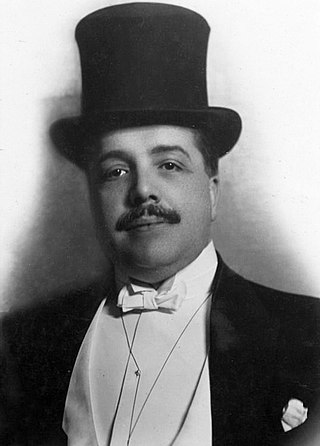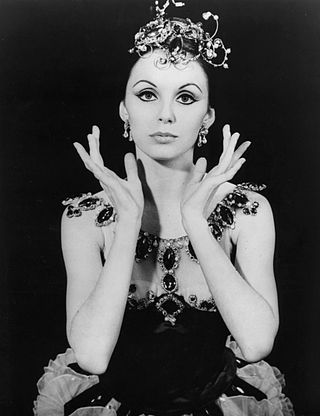Reviews
|
|
Echo is a ballet made by New York City Ballet ballet master (subsequently ballet master in chief) Peter Martins to Michael Torke's Slate (1989). The premiere took place on 15 June 1989 at the New York State Theater, Lincoln Center. Echo was the third in a series of collaborations between the choreographer and composer.
|
|

Sergei Pavlovich Diaghilev, also known as Serge Diaghilev, was a Russian art critic, patron, ballet impresario and founder of the Ballets Russes, from which many famous dancers and choreographers would arise.

George Balanchine was a Georgian-American ballet choreographer, recognized as one of the most influential choreographers of the 20th-century. Styled as the father of American ballet, he co-founded the New York City Ballet and remained its artistic director for more than 35 years. His choreography is characterized by plotless ballets with minimal costume and décor, performed to classical and neoclassical music.

Mikhail Nikolayevich Baryshnikov is a Latvian and American dancer, choreographer, and actor. He was the preeminent male classical ballet dancer of the 1970s and 1980s. He subsequently became a noted dance director.

The Bolshoi Ballet is an internationally renowned classical ballet company based at the Bolshoi Theatre in Moscow, Russia. Founded in 1776, the Bolshoi is among the world's oldest ballet companies. In the early 20th century, it came to international prominence as Moscow became the capital of Soviet Russia. The Bolshoi has been recognised as one of the foremost ballet companies in the world. It has a branch at the Bolshoi Ballet Theater School in Joinville, Brazil.

The Paris Opera Ballet is a French ballet company that is an integral part of the Paris Opera. It is the oldest national ballet company, and many European and international ballet companies can trace their origins to it. It is still regarded as one of the four most prominent ballet companies in the world, together with the Bolshoi Ballet in Moscow, the Mariinsky Ballet in Saint Petersburg and the Royal Ballet in London.

Suzanne Farrell is a former American ballerina and the founder of the Suzanne Farrell Ballet at the Kennedy Center in Washington, D.C.
The School of American Ballet (SAB) is the associate school of the New York City Ballet, a ballet company based at the Lincoln Center for the Performing Arts in New York City. The school trains students from the age of six, with professional vocational ballet training for students aged 11–18. Graduates of the school achieve employment with leading ballet companies worldwide, and in the United States with New York City Ballet, American Ballet Theatre, Boston Ballet, San Francisco Ballet, Miami City Ballet, Pacific Northwest Ballet and Houston Ballet.
Philadelphia Ballet is the largest ballet company in Philadelphia. The company's annual local season features six programs of classic pieces, such as George Balanchine's The Nutcracker, in addition to presentations of new works. The company's artistic director is Angel Corella.

Judith Ann Jamison was an American dancer and choreographer. She danced with the Alvin Ailey American Dance Theater from 1965 to 1980 and was Ailey's muse. She later returned to be the company's artistic director from 1989 until 2011, and then its artistic director emerita. She received the Kennedy Center Honors in 1999, the National Medal of Arts in 2001, and the Handel Medallion, New York City's highest cultural honor, in 2010.
John Neumeier is an American ballet dancer, choreographer, and director. He was the Director and Principal Choreographer of Hamburg Ballet from 1973-2024 and the Artistic Director Ballet at Hamburg State Opera from 1996-2024.

Boris Eifman is a Russian choreographer and artistic director. He has done more than fifty ballet productions.

Miami City Ballet is an American ballet company based in Miami Beach, Florida, led by artistic director Lourdes Lopez.
Black and White is a ballet made by New York City Ballet ballet master, subsequently ballet master in chief, Peter Martins to some of Michael Torke's eponymous music which was commissioned for City Ballet's American Music Festival; the premiere took place on 7 May 1988 at the New York State Theater, Lincoln Center. Black and White was the second in a series of collaborations between the choreographer and composer.
Ash is a ballet made by New York City Ballet's ballet master in chief Peter Martins to Ash (1991) by Michael Torke. The premiere took place Thursday, June 20, 1991, at the New York State Theater, Lincoln Center. Ash was the fourth in a series of collaborations between the choreographer and composer.

Patricia McBride is a ballerina who spent nearly 30 years dancing with the New York City Ballet. McBride joined the New York City Ballet in 1959. She became a principal in 1961, becoming the company's youngest principal. She danced with the company for 30 years, including roles created for her by choreographers George Balanchine and Jerome Robbins.
Ecstatic Orange is a ballet made by New York City Ballet ballet master Peter Martins to Michael Torke's Verdant Music (1985), Purple (1987) and Ecstatic Orange (1985) for City Ballet's American Music Festival; the second movement, Purple, was to a score commissioned for the occasion. The premiere of the expanded version took place on 11 June 1987 at the New York State Theater, Lincoln Center, with lighting by Mark Stanley Ecstatic Orange was the first in a series of collaborations between the choreographer and composer.

Who Cares? is a ballet choreographed by George Balanchine to songs by George Gershwin that were orchestrated by Hershy Kay. The ballet is split in two parts, the first danced by an ensemble, and the second focuses on four principal dancers. Who Cares? premiered on February 5, 1970, at the New York State Theater, danced by the New York City Ballet.
Balanchine technique or Balanchine method is the ballet performance style invented by dancer, choreographer, and teacher George Balanchine (1904–1983), and a trademark of the George Balanchine Foundation. It is used widely today in many of Balanchine's choreographic works. It is employed by ballet companies and taught in schools throughout North America, including the New York City Ballet and School of American Ballet, where it first emerged.